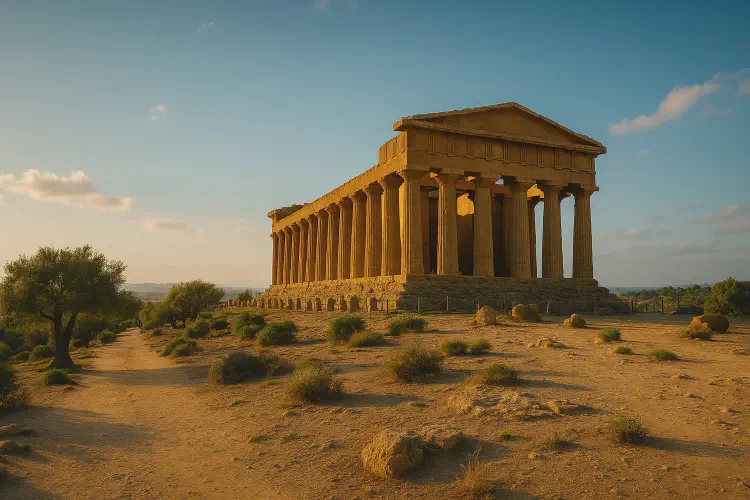Greek ruins in Sicily
Sicily was once the heart of **Magna Graecia**, the “Great Greece” of the western Mediterranean. Between the 8th and 3rd centuries BCE, Greek settlers built grand temples, theatres, and cities that still stand today as breathtaking testaments to classical civilization.
- Visit Sicily
- 3 min read

Greek Ruins in Sicily — Traces of Magna Graecia
🏛️ Overview
The Greeks arrived in Sicily around 734 BCE, founding powerful colonies such as Syracuse, Agrigento, Selinunte, and Segesta. These city-states rivaled those of mainland Greece in wealth and sophistication. Today, their ruins remain among the best-preserved examples of Greek art and architecture outside Greece itself.
From temples and theatres to city walls and necropolises, Sicily offers a journey through the ancient world, revealing how Hellenic culture shaped the island’s identity for centuries.
🏺 Most Important Greek Sites in Sicily
1. Valley of the Temples (Agrigento)
Perhaps the most iconic archaeological site in Sicily, the Valley of the Temples (Valle dei Templi) is a UNESCO World Heritage Site featuring eight monumental Doric temples from the 5th century BCE.
- Temple of Concordia: one of the best-preserved Greek temples in the world.
- Temple of Juno and Temple of Heracles: striking examples of classical symmetry.
- Temple of Zeus Olympios: once among the largest temples ever constructed.
The site also includes ancient necropolises, sanctuaries, and olive groves that bring history vividly to life.
2. Selinunte Archaeological Park
On Sicily’s southwest coast near Castelvetrano lies Selinunte, once a flourishing Greek city destroyed by the Carthaginians in 409 BCE. Today it forms Europe’s largest archaeological park, covering 270 hectares.
- Temple E (Hera): beautifully restored and photogenic.
- Temple F and G: massive ruins showcasing the city’s scale.
- The Acropolis and surrounding temples are set against the sea, making it one of the most atmospheric sites in the Mediterranean.
3. Segesta
Located inland between Palermo and Trapani, Segesta was founded by the Elymians but heavily influenced by Greek culture.
- Doric Temple: perfectly preserved, standing alone among rolling hills — never completed but stunningly intact.
- Greek Theatre: carved into a hilltop with breathtaking views toward the sea and surrounding countryside.
4. Syracuse (Siracusa)
Once one of the most powerful cities in Magna Graecia, Syracuse was home to the mathematician Archimedes and a major naval force.
- Greek Theatre: one of the largest of the ancient world, still used for classical plays today.
- Ear of Dionysius: a cave in the quarry where slaves once worked, famous for its acoustics.
- Temple of Apollo and Temple of Athena (now Syracuse Cathedral): show how Greek buildings evolved into later Christian forms.
5. Taormina Ancient Theatre
Originally Greek (later modified by the Romans), the Teatro Antico di Taormina overlooks the sea and Mount Etna — an unparalleled setting for ancient drama. Today it hosts performances and concerts, maintaining its original purpose as a place of art and storytelling.
6. Heraclea Minoa
Located west of Agrigento, this lesser-known site sits dramatically on a cliff overlooking the sea. It features a Greek theatre carved into the rock, ancient walls, and a peaceful setting far from crowds.
🏺 Greek Legacy in Sicily
The Greeks brought with them democracy, philosophy, and artistic ideals that transformed the island’s culture. Many Sicilian towns still carry Greek names, and festivals celebrating classical theatre in Syracuse and Taormina keep the spirit of antiquity alive.
The island’s archaeological museums — particularly in Syracuse, Agrigento, and Palermo — hold exquisite artifacts: pottery, statues, and inscriptions that reveal daily life in ancient Sicily.
🧭 Summary
Exploring the Greek ruins of Sicily is like walking through an open-air museum of Western civilization. From the grandeur of Agrigento to the serenity of Segesta and the drama of Taormina, these ancient stones tell the story of an island that once stood at the crossroads of Greek art, religion, and power — and still echoes with the voices of its legendary past.